The Intel 6th Gen Skylake Review: Core i7-6700K and i5-6600K Tested
by Ian Cutress on August 5, 2015 8:00 AM ESTWhat You Can Buy: Linux Performance
Built around several freely available benchmarks for Linux, Linux-Bench is a project spearheaded by Patrick at ServeTheHome to streamline about a dozen of these tests in a single neat package run via a set of three commands using an Ubuntu 11.04 LiveCD. These tests include fluid dynamics used by NASA, ray-tracing, OpenSSL, molecular modeling, and a scalable data structure server for web deployments. We run Linux-Bench and have chosen to report a select few of the tests that rely on CPU and DRAM speed.
C-Ray: link
C-Ray is a simple ray-tracing program that focuses almost exclusively on processor performance rather than DRAM access. The test in Linux-Bench renders a heavy complex scene offering a large scalable scenario.
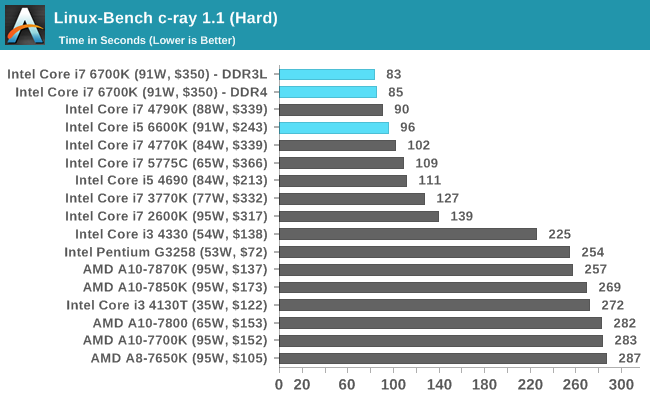
NAMD, Scalable Molecular Dynamics: link
Developed by the Theoretical and Computational Biophysics Group at the University of Illinois at Urbana-Champaign, NAMD is a set of parallel molecular dynamics codes for extreme parallelization up to and beyond 200,000 cores. The reference paper detailing NAMD has over 4000 citations, and our testing runs a small simulation where the calculation steps per unit time is the output vector.
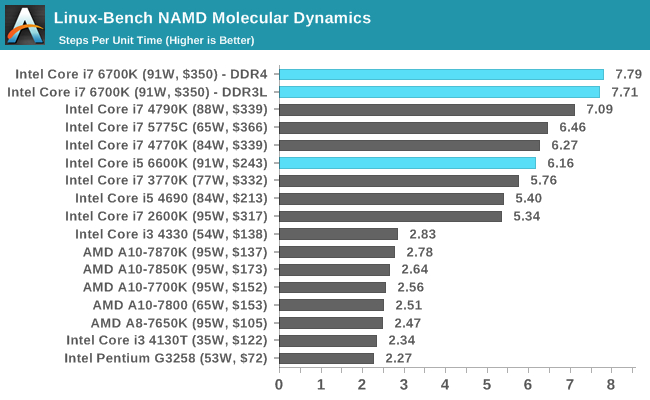
NPB, Fluid Dynamics: link
Aside from LINPACK, there are many other ways to benchmark supercomputers in terms of how effective they are for various types of mathematical processes. The NAS Parallel Benchmarks (NPB) are a set of small programs originally designed for NASA to test their supercomputers in terms of fluid dynamics simulations, useful for airflow reactions and design.
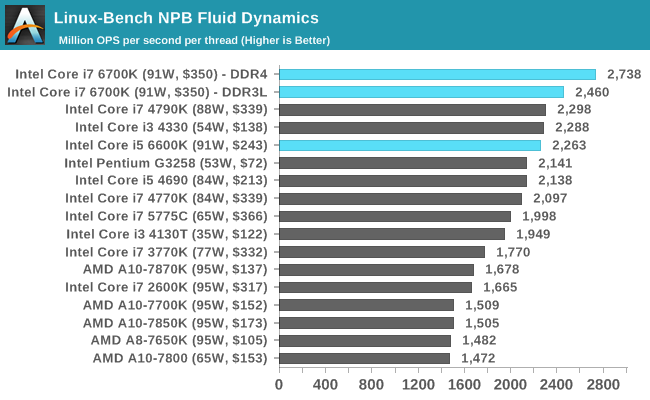
Redis: link
Many of the online applications rely on key-value caches and data structure servers to operate. Redis is an open-source, scalable web technology with a b developer base, but also relies heavily on memory bandwidth as well as CPU performance.
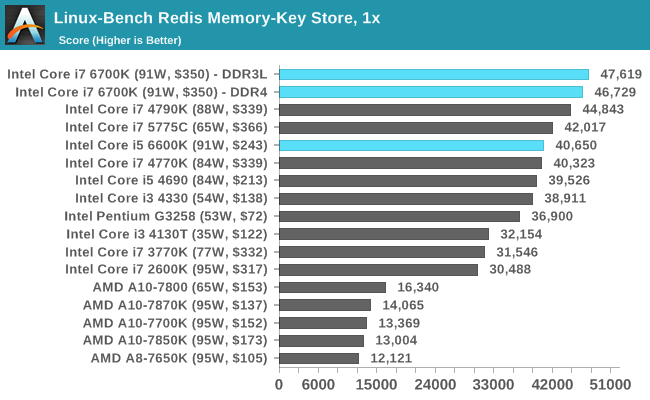
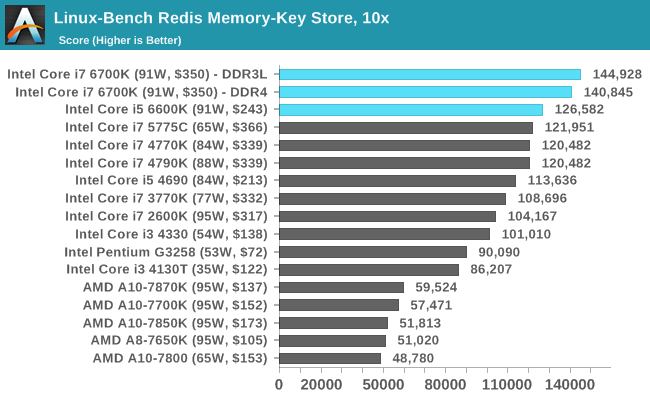
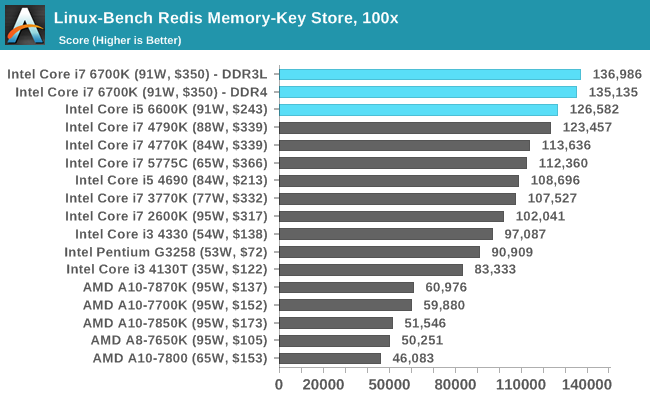










477 Comments
View All Comments
zShowtimez - Wednesday, August 5, 2015 - link
With 0 competition at the high end, its not really a surprise.Refuge - Wednesday, August 5, 2015 - link
^this^darkfalz - Wednesday, August 5, 2015 - link
Yeah, sad. Single digit generational IPC improvements and a trickle up of clockspeed - not exactly exciting times in the CPU world. But I'm kind of happy, in a way, as who wants to have to upgrade their whole system rather than just the GPU every 2 years. It strikes me that Intel are doing a pissload of work for very little results though.wallysb01 - Wednesday, August 5, 2015 - link
What’s lost is that these gains are coming with roughly zero increased power draw. Much of the gains of years past were largely due to being able to increase the power consumption without melting things. Today, we’ve picked all the low hanging fruit in that regard. There is just no point in being disappointed in 5-10% increases in performance, as time moves on its only going to get worse.There is also no point in getting mad at AMD for not providing competition to push intel or at Intel for not pushing themselves enough. If added performance was easy to come by we’d see Intel/AMD or some random start up do it. The market is huge and if Intel could suddenly double performance (or cut power draw in half with the same performance) they would do it. They want you to replace your old Intel machine with a new one just as much as they want to make sure your new computer is Intel rather than AMD.
boeush - Thursday, August 6, 2015 - link
And yet, one would expect much lower operating voltage and/or much higher base clocks with a new architecture on a 14nm process, as compared to the 22nm Haswell. The relatively tiny improvements in everything except iGPU speaks to either misplaced design priorities (i.e. incompetence) or ongoing problems with the 14nm process...Achaios - Wednesday, August 5, 2015 - link
Very often. You are simply NOT a gamer. There are games that depend almost completely on CPU single threaded performance: World of Warcraft, Total War series games, Starcraft II, etc.Nagorak - Wednesday, August 5, 2015 - link
The games you listed aren't ones where I'd think having hundreds of FPS would be necessary.jeffkibuule - Thursday, August 6, 2015 - link
FPS can vary wildly because so many units end up on screen.vdek - Thursday, August 6, 2015 - link
I'm a gamer, I plan a ton of SCII, my Xeon 5650 6 core @ 4.2 ghz does just fine on any of those mentioned games. Why should I upgrade?Kjella - Wednesday, August 5, 2015 - link
Yeah. I upgraded from the i7-860 to the i7-4790K, the only two benchmarks they have in common in Bench suggests that's roughly a 100% upgrade. And a lot of that is the huge boost to base clock on the 4790 vs the 4770, I prefer running things at stock speed since in my experience all computers are a bit unstable and I'd rather not wonder if it's my overclocking..
At this rate it looks like any Sandy Bridge or newer is basically "use it until it breaks", at 5-10% increase/generation there's no point in upgrading for raw performance. 16GB sticks only matter if you want more than 4x8GB RAM. PCIe 3.0 seems plenty fast enough. And while there's a few faster connectors, that's accessories. The biggest change is the SSD and there you can always add an Intel 750 PCIe card instead for state of the art 4x PCIe 3.0 NVME drive. Makes more sense than replacing the system.